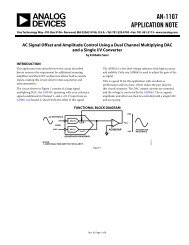Ahmad Bahai - EEWeb
Ahmad Bahai - EEWeb
Ahmad Bahai - EEWeb
Create successful ePaper yourself
Turn your PDF publications into a flip-book with our unique Google optimized e-Paper software.
As I look at TI’s<br />
product portfolio of<br />
almost 45,000 analog<br />
products, I see a<br />
challenge – to leverage<br />
this expansive portfolio<br />
by bringing products<br />
together and then<br />
stepping back to<br />
solve problems more<br />
efficiently with the<br />
right combination<br />
of these products—<br />
ranging from basic<br />
semiconductor<br />
and packaging<br />
technologies to circuits<br />
and systems.<br />
think we will lose some of our top<br />
talents to non-hardware or nonelectronics<br />
parts of the hardware,<br />
which may tax us in the long run. I<br />
fear that a lot of students will move<br />
into applications design rather than<br />
driving innovation in hardware. We<br />
need to remind everyone that all of<br />
the social media applications that<br />
we use today for example require<br />
extremely capable and powerefficient<br />
semiconductor hardware to<br />
provide, which is a result of decades<br />
of innovation. Another challenge I<br />
see is ensuring multidisciplinary<br />
education for electrical engineering<br />
students. Many innovations today<br />
are a convergence of several types<br />
of technologies. The innovator<br />
today needs to be able to leverage<br />
the capabilities of all of these<br />
technologies together to really open<br />
the door for new opportunities.<br />
Do you have any advice for<br />
the electrical engineering<br />
community to help the<br />
development of these new<br />
innovations?<br />
I think it is very important to develop<br />
new ways to shorten the cycle of<br />
innovation. Particularly, reducing<br />
the amount of time between<br />
coming up with a great idea and<br />
the commercialization of that idea.<br />
At Silicon Valley Labs, we work<br />
extensively in analog and mixedsignal<br />
processing to discover the<br />
next big thing. The challenge is to<br />
make the development process<br />
more efficient. Over the last few<br />
years, we discovered through<br />
practice a collaborative way of<br />
innovating. Collaboration can really<br />
Visit www.eeweb.com<br />
INTERVIEW<br />
help bring ideas from their infancy<br />
to the point of realistic evaluation.<br />
Today, we work with people at the<br />
top schools on projects, not in the<br />
classic way of funding a project and<br />
reporting back every six months,<br />
but getting heavily involved and<br />
spending time with the team and<br />
bouncing ideas off of each other.<br />
This interaction really helps take<br />
ideas from the whiteboard to the<br />
development of hardware in an<br />
amazingly short period of time.<br />
It’s very competitive out there<br />
and having these innovations can<br />
give us a six-month window over<br />
our competition. We extend that<br />
window with more innovation.<br />
Back in the old days the best way<br />
to protect your innovation was to<br />
patent it. Nowadays, the best way to<br />
protect your innovation is with more<br />
innovation. ■<br />
7















